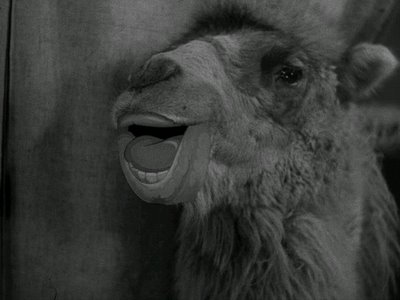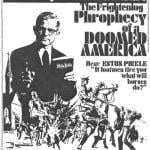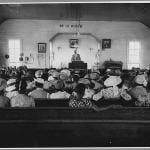Does anyone talk about post-modernism any more? I remember discussing that subject with quite a few people back in the ’90s — when movies were full of references to other movies, and when CGI threatened to replace actual reality with virtual reality, etc. — but I haven’t heard it come up much in conversation lately.
At any rate, one of the things I love about old movies is seeing how the gags and themes and techniques that seem so newfangled nowadays actually go back to the earliest days of the artform. Yesterday I happened to watch three such movies from the 1940s.
 Two, Road to Zanzibar (1941) and Road to Morocco (1942), are part of the “Road” series that starred Bob Hope, Bing Crosby and Dorothy Lamour, and both films are very conscious of their own movie-ness. In Zanzibar, there is a scene where Bing and Dorothy are in a boat, paddling down a river, and Dorothy says she saw a movie once where someone in a similar situation started to sing, and suddenly there was an orchestra on the soundtrack, even though there was clearly no orchestra in the jungle — and then Bing starts to sing to her. Thus, the film draws our attention to the artificiality of the very scene that we are watching!
Two, Road to Zanzibar (1941) and Road to Morocco (1942), are part of the “Road” series that starred Bob Hope, Bing Crosby and Dorothy Lamour, and both films are very conscious of their own movie-ness. In Zanzibar, there is a scene where Bing and Dorothy are in a boat, paddling down a river, and Dorothy says she saw a movie once where someone in a similar situation started to sing, and suddenly there was an orchestra on the soundtrack, even though there was clearly no orchestra in the jungle — and then Bing starts to sing to her. Thus, the film draws our attention to the artificiality of the very scene that we are watching!
Then there is the scene near the end of Morocco in which all sorts of looney mayhem breaks out, and a camel on the sidelines suddenly speaks, saying: “This is the screwiest picture I was ever in.” The camel is live-action, but his mouth is a cartoon. Two minutes later, a female camel says, “When I see how silly people behave, I’m glad I’m a camel.” The male camel replies, “Well I’m glad you’re a camel too, Mabel!” and rolls his eyes suggestively. It’s a wonderfully absurd moment, and the animation in this scene is a direct precursor to all those movies we see nowadays in which otherwise live-action animals talk with CGI mouths.
 Then, on a very different note, there was Bedlam (1946), the last of producer Val Lewton’s collaborations with Boris Karloff. The story concerns an asylum in the 18th century, an era which, the opening titles note, was called “the Age of Reason”; and the film concerns a contest of sorts between the cruel, cynical, legalistic apothecary-general played by Karloff and a Quaker (played by Richard Fraser) who believes that all people, even the insane, are worthy of pity. Anna Lee plays a woman who wants to help the asylum’s inmates, and both Karloff and the Quaker take turns trying to impress their views on her.
Then, on a very different note, there was Bedlam (1946), the last of producer Val Lewton’s collaborations with Boris Karloff. The story concerns an asylum in the 18th century, an era which, the opening titles note, was called “the Age of Reason”; and the film concerns a contest of sorts between the cruel, cynical, legalistic apothecary-general played by Karloff and a Quaker (played by Richard Fraser) who believes that all people, even the insane, are worthy of pity. Anna Lee plays a woman who wants to help the asylum’s inmates, and both Karloff and the Quaker take turns trying to impress their views on her.
The film’s overt criticism of “the Age of Reason” was enough to get my attention, but I was also surprised by one particularly bizarre moment within the asylum, in which inmate Sidney Long (Ian Wolfe) shows John Gray (Harry Harvey) a flip-it animation that he has drawn in the corners of the pages of one of his books:
GRAY: But this book you have, those drawings —
LONG: Oh, the pictures. You don’t know half their wonder, Master Gray. If I could only get a light behind these pages, I could throw them large as life upon the wall.
GRAY: Aye, that’s not a bad notion. One could charge admission! You could even tell the story Todd’s writing that way.
LONG: Oh, but you forget, it’s because of these pictures that I’m here. That, and because I’m the best lawyer in England — aye, the most skilled of them all!
Suffice to say that Long is a little too forceful in the way he insists upon his skills as a lawyer; it’s clear that he is a little insane. But I was a bit startled to see, in the midst of this mostly serious and occasionally even grim period piece, a discussion of motion pictures, a century and then some before their time! This isn’t the sort of film that you’d expect to “wink” at the audience like that.











